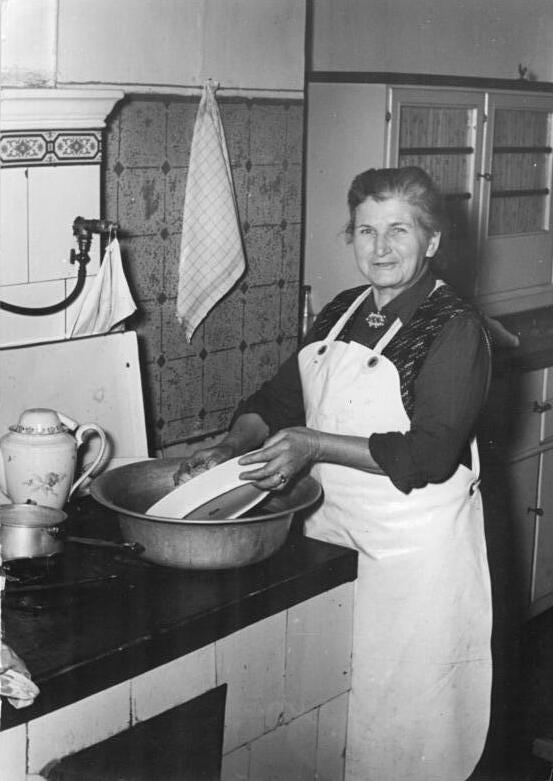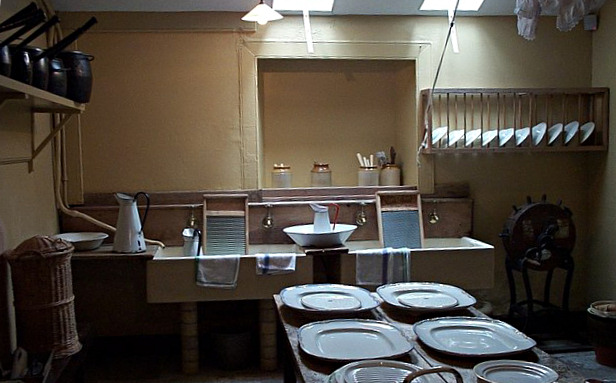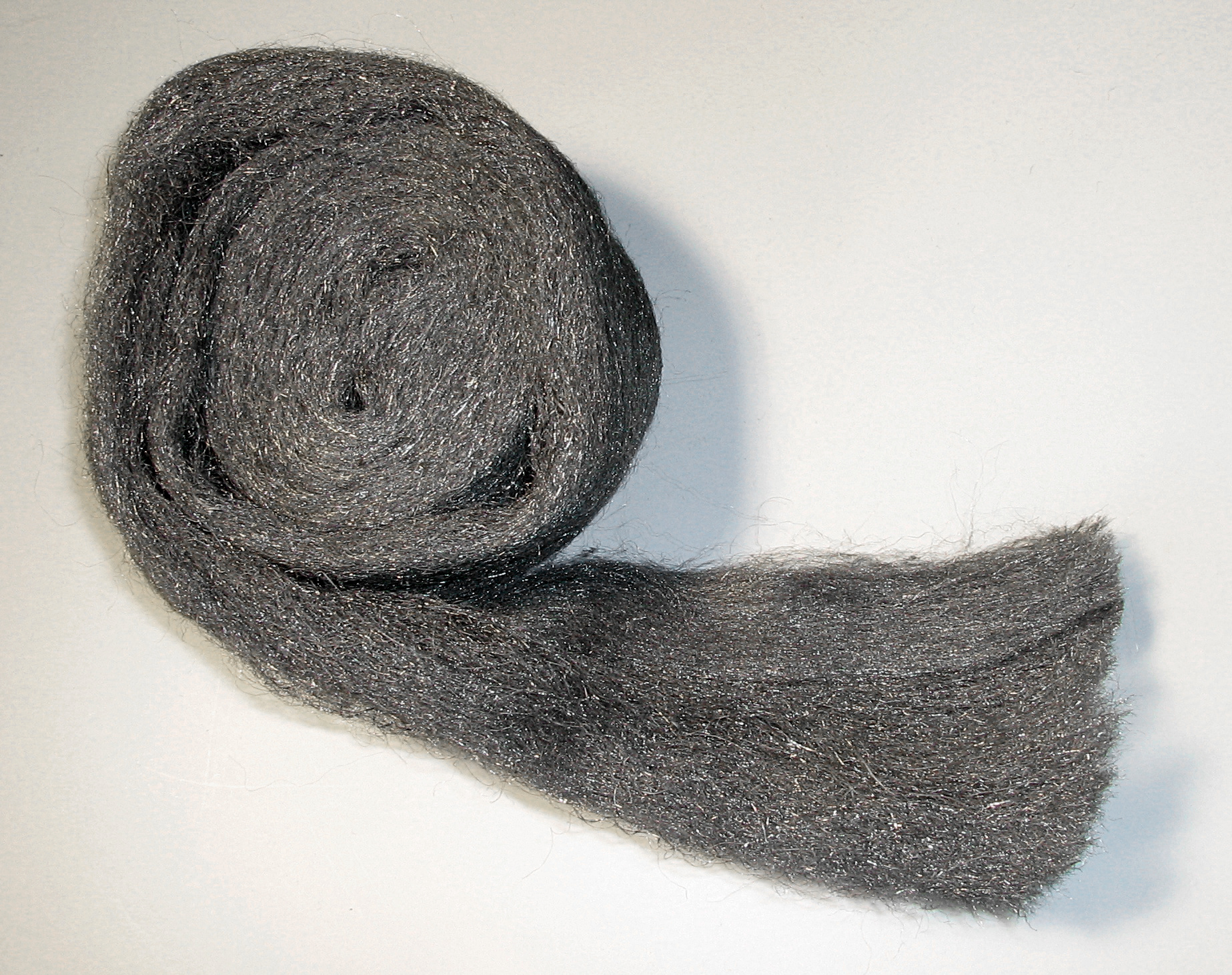|
Dishwashing
Dishwashing, washing the dishes, doing the dishes, or washing up in Great Britain, is the process of cleaning cooking utensils, dishes, cutlery and other items to prevent foodborne illness. This is either achieved by hand in a sink using dishwashing detergent or by using a dishwasher and may take place in a kitchen, utility room, scullery or elsewhere. There are cultural divisions over rinsing and drying after washing. Implements Dish washing is usually done using an implement for the washer to wield, unless done using an automated dishwasher. Commonly used implements include cloths, sponges, brushes or even steel wool. As fingernails are often more effective than soft implements like cloths at dislodging hard particles, washing simply with the hands is also done and can be effective as well. Dishwashing detergent is also generally used, but bar soap can be used acceptably, as well. Rubber gloves are often worn when washing dishes by people who are sensitive to hot water ... [...More Info...] [...Related Items...] OR: [Wikipedia] [Google] [Baidu] |
Dishwashing Detergent
Dishwashing liquid (or washing-up liquid in British English), also known as dishwashing soap, dish detergent, and dish soap is a detergent used to assist in dishwashing. It is usually a highly-foaming mixture of surfactants with low skin irritation, and is primarily used for hand washing of glasses, plates, cutlery, and cooking utensils in a sink or bowl. In addition to its primary use, dishwashing liquid also has various informal applications, such as for creating bubbles, clothes washing and cleaning oil-affected birds. History Washing soda (sodium carbonate) is used for dishwashing, and may be used in areas with hard water. It was used for dishwashing before detergents were invented in Germany during World War I. Liquid detergent used for dishwashing was first manufactured in the middle of the 20th century. Dishwashing detergent producers started production in the United States in the 1930–1940s. Teepol, the first such in Europe, commenced production in 1942. In 20 ... [...More Info...] [...Related Items...] OR: [Wikipedia] [Google] [Baidu] |
Dishwashing Detergent
Dishwashing liquid (or washing-up liquid in British English), also known as dishwashing soap, dish detergent, and dish soap is a detergent used to assist in dishwashing. It is usually a highly-foaming mixture of surfactants with low skin irritation, and is primarily used for hand washing of glasses, plates, cutlery, and cooking utensils in a sink or bowl. In addition to its primary use, dishwashing liquid also has various informal applications, such as for creating bubbles, clothes washing and cleaning oil-affected birds. History Washing soda (sodium carbonate) is used for dishwashing, and may be used in areas with hard water. It was used for dishwashing before detergents were invented in Germany during World War I. Liquid detergent used for dishwashing was first manufactured in the middle of the 20th century. Dishwashing detergent producers started production in the United States in the 1930–1940s. Teepol, the first such in Europe, commenced production in 1942. In 20 ... [...More Info...] [...Related Items...] OR: [Wikipedia] [Google] [Baidu] |
Dishwasher
A dishwasher is a machine that is used to clean dishware, cookware, and cutlery automatically. Unlike manual dishwashing, which relies heavily on physical scrubbing to remove soiling, the mechanical dishwasher cleans by spraying hot water, typically between , at the dishes, with lower temperatures of water used for delicate items. A mix of water and dishwasher detergent is pumped to one or more rotating sprayers, cleaning the dishes with the cleaning mixture. The mixture is recirculated to save water and energy. Often there is a pre-rinse, which may or may not include detergent, and the water is then drained. This is followed by the main wash with fresh water and detergent. Once the wash is finished, the water is drained; more hot water enters the tub by means of an electromechanical solenoid valve, and the rinse cycle(s) begin. After the rinse process finishes, the water is drained again and the dishes are dried using one of several drying methods. Typically a rinse-aid, a ... [...More Info...] [...Related Items...] OR: [Wikipedia] [Google] [Baidu] |
Dishwasher
A dishwasher is a machine that is used to clean dishware, cookware, and cutlery automatically. Unlike manual dishwashing, which relies heavily on physical scrubbing to remove soiling, the mechanical dishwasher cleans by spraying hot water, typically between , at the dishes, with lower temperatures of water used for delicate items. A mix of water and dishwasher detergent is pumped to one or more rotating sprayers, cleaning the dishes with the cleaning mixture. The mixture is recirculated to save water and energy. Often there is a pre-rinse, which may or may not include detergent, and the water is then drained. This is followed by the main wash with fresh water and detergent. Once the wash is finished, the water is drained; more hot water enters the tub by means of an electromechanical solenoid valve, and the rinse cycle(s) begin. After the rinse process finishes, the water is drained again and the dishes are dried using one of several drying methods. Typically a rinse-aid, a ... [...More Info...] [...Related Items...] OR: [Wikipedia] [Google] [Baidu] |
Washing Dishes
Dishwashing, washing the dishes, doing the dishes, or washing up in Great Britain, is the process of cleaning cooking utensils, dishes, cutlery and other items to prevent foodborne illness. This is either achieved by hand in a sink using dishwashing detergent or by using a dishwasher and may take place in a kitchen, utility room, scullery or elsewhere. There are cultural divisions over rinsing and drying after washing. Implements Dish washing is usually done using an implement for the washer to wield, unless done using an automated dishwasher. Commonly used implements include cloths, sponges, brushes or even steel wool. As fingernails are often more effective than soft implements like cloths at dislodging hard particles, washing simply with the hands is also done and can be effective as well. Dishwashing detergent is also generally used, but bar soap can be used acceptably, as well. Rubber gloves are often worn when washing dishes by people who are sensitive to hot water or ... [...More Info...] [...Related Items...] OR: [Wikipedia] [Google] [Baidu] |
Scullery (room)
A scullery is a room in a house, traditionally used for washing up dishes and laundering clothes, or as an overflow kitchen. Tasks performed in the scullery include cleaning dishes and cooking utensils (or storing them), occasional kitchen work, ironing, boiling water for cooking or bathing, and soaking and washing clothes. Sculleries contain hot and cold sinks, sometimes slop sinks, drain pipes, storage shelves, plate racks, a work table, various coppers for boiling water, tubs, and buckets. The term "scullery" has fallen into disuse in North America, as laundry takes place in a utility room or laundry room. The term continues in use in its original sense in Britain and Ireland amongst the middle classes, or as an alternative term for kitchen in some regions of Britain, typically Northern Ireland, North East England and Scotland, or in designer kitchens. In United States military facilities and most commercial restaurants, a "scullery" refers to the section of a dining facil ... [...More Info...] [...Related Items...] OR: [Wikipedia] [Google] [Baidu] |
Rubber Gloves
A rubber glove is a glove made out of natural rubber or Synthetic rubber. The term ‘rubber’ refers to durable, waterproof and elastic material made from natural or synthetic latex. Rubber gloves can be unsupported (rubber only) or supported (rubber coating of textile glove). Its primary purpose is protection of the hands while performing tasks involving chemicals. Rubber gloves can be worn during dishwashing to protect the hands from detergent and allow the use of hotter water. Sometimes caregivers will use rubber gloves during the diaper changing process to prevent contact with the child's fecal material/urine. Health professionals use medical gloves rather than rubber gloves when performing surgical operations. Origin In 1894, William Stewart Halsted, the first chief of surgery at Johns Hopkins Hospital, invented rubber gloves for his wife Caroline Hampton as he noticed her hands were affected on the daily surgeries she had performed and in order to prevent medical staf ... [...More Info...] [...Related Items...] OR: [Wikipedia] [Google] [Baidu] |
Aprons
An apron is a garment that is worn over other clothing to cover the front of the body. The word comes from old French ''napron'' meaning a small piece of cloth, however over time "a napron" became "an apron", through a linguistics process called rebracketing. It may have several purposes, typically as a functional accessory that protects clothes and skin from stains and marks. However, other types of aprons may be worn as a decoration, for hygienic reasons, as part of a uniform, or as protection from certain dangers such as acid, allergens or excessive heat. It can also be used at work stations to hold extra tools and pieces or protect from dust and unwanted materials. As a top layer that covers the front body, the apron is also worn as a uniform, adornment, ceremonial garb (e.g. Masonic apron) or fashion statement. Apron styles can be practical, fashionable, and sentimental. Apron styles There are many different apron forms depending on the purpose of the apron. A basic dis ... [...More Info...] [...Related Items...] OR: [Wikipedia] [Google] [Baidu] |
Restaurants
A restaurant is a business that prepares and serves food and drinks to customers. Meals are generally served and eaten on the premises, but many restaurants also offer take-out and food delivery services. Restaurants vary greatly in appearance and offerings, including a wide variety of cuisines and service models ranging from inexpensive fast-food restaurants and cafeterias to mid-priced family restaurants, to high-priced luxury establishments. Etymology The word derives from early 19th century from French word 'provide food for', literally 'restore to a former state' and, being the present participle of the verb, The term ''restaurant'' may have been used in 1507 as a "restorative beverage", and in correspondence in 1521 to mean 'that which restores the strength, a fortifying food or remedy'. History A public eating establishment similar to a restaurant is mentioned in a 512 BC record from Ancient Egypt. It served only one dish, a plate of cereal, wild fowl, and onio ... [...More Info...] [...Related Items...] OR: [Wikipedia] [Google] [Baidu] |
Parliament Of The United Kingdom
The Parliament of the United Kingdom is the supreme legislative body of the United Kingdom, the Crown Dependencies and the British Overseas Territories. It meets at the Palace of Westminster, London. It alone possesses legislative supremacy and thereby ultimate power over all other political bodies in the UK and the overseas territories. Parliament is bicameral but has three parts, consisting of the sovereign ( King-in-Parliament), the House of Lords, and the House of Commons (the primary chamber). In theory, power is officially vested in the King-in-Parliament. However, the Crown normally acts on the advice of the prime minister, and the powers of the House of Lords are limited to only delaying legislation; thus power is ''de facto'' vested in the House of Commons. The House of Commons is an elected chamber with elections to 650 single-member constituencies held at least every five years under the first-past-the-post system. By constitutional convention, all govern ... [...More Info...] [...Related Items...] OR: [Wikipedia] [Google] [Baidu] |
Steel Wool
Steel wool, also known as iron wool, wire wool or wire sponge, is a bundle of very fine and flexible sharp-edged steel filaments. It was described as a new product in 1896.''Iron Age'', Vol. LVII, p.871, cited by ''Journal of the Iron and Steel Institute'', Volume 50, Issue 2, p.48/ref> It is used as an abrasive in finishing and repair work for polishing wood or metal objects, cleaning household cookware, cleaning windows, and sanding surfaces. Steel wool is made from low-carbon steel in a process similar to broaching, where a heavy steel wire is pulled through a toothed die that removes thin, sharp, wire shavings. Uses Steel wool is commonly used by woodworkers, metal craftsmen, and jewelers to clean and smooth working surfaces and give them shine. However, when used on oak, remaining traces of iron may react with tannins in the wood to produce blue or black iron stain, and when used on aluminum, brass, or other non-ferrous metal surfaces may cause after-rust which will du ... [...More Info...] [...Related Items...] OR: [Wikipedia] [Google] [Baidu] |
Sodium Hypochlorite
Sodium hypochlorite (commonly known in a dilute solution as bleach) is an inorganic chemical compound with the formula NaOCl (or NaClO), comprising a sodium cation () and a hypochlorite anion (or ). It may also be viewed as the sodium salt of hypochlorous acid. The anhydrous compound is unstable and may decompose explosively. It can be crystallized as a pentahydrate ·5, a pale greenish-yellow solid which is not explosive and is stable if kept refrigerated. Sodium hypochlorite is most often encountered as a pale greenish-yellow dilute solution referred to as liquid bleach, which is a household chemical widely used (since the 18th century) as a disinfectant or a bleaching agent. In solution, the compound is unstable and easily decomposes, liberating chlorine, which is the active principle of such products. Sodium hypochlorite is the oldest and still most important chlorine-based bleach. Its corrosive properties, common availability, and reaction products make it ... [...More Info...] [...Related Items...] OR: [Wikipedia] [Google] [Baidu] |





.jpg)



